 There has been a murder! Many years ago, an ancient mansion was the site of a horrible crime. A crime in which the owner of the house was falsely convicted and sent to prison (I swear I’m not doing a review of the A-Team here, stay with me). That poor man died in prison and has since returned to the walls of his old home as a ghost to pester the current inhabitants. They now need you, an intrepid group of paranormal experts, to put his soul to rest.
There has been a murder! Many years ago, an ancient mansion was the site of a horrible crime. A crime in which the owner of the house was falsely convicted and sent to prison (I swear I’m not doing a review of the A-Team here, stay with me). That poor man died in prison and has since returned to the walls of his old home as a ghost to pester the current inhabitants. They now need you, an intrepid group of paranormal experts, to put his soul to rest.
That’s the great theme of today’s review of Mysterium (currently for sale in Europe as Tajemnicze Domostwo), a cooperative deduction game that will have you racing the clock to solve the mystery. Can you help put the spirit to rest?
Mysterium is a cooperative deduction game for 2-7 players that takes about 45 minutes to play.Mysterium plays best for 4-5 players.
Game Overview:
So a ghost is haunting this old mansion and you need to put its spirit to rest. No problem right? Now how do you go about doing that? In Mysterium, one player takes on the role of the ghost that will be providing clues to the investigators in the form of dreams. Each night, the investigators will get a dream card that will give those hints as to the true culprit of the crime. If they can figure out who did the deed, where it was done, and with what weapon, they’ll be able to put the ghost to rest and win the game (and get paid I’m assuming).
Game Components:
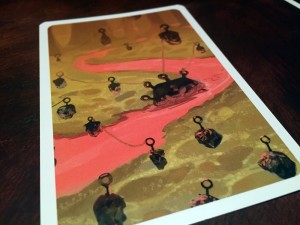
While Mysterium is not currently available in English, the game is language independent so that won’t hamper your ability to play. An English copy of the rulebook is freely available online and once you start playing the game, no text is used, just artwork.
The cards are the main component of the game and wonderfully done. There are a number of different cards in the game, and I was a big fan of the illustrator they used. If you are a fan of the artwork in Dixit, then I think you will enjoy the artwork in Mysterium.
In addition to the cards, there are a number of wooden and cardboard tokens that players will use to track their progress throughout the game. The most important of these is the calendar track that acts as the game’s timer.
I should also note that there are currently two different versions of the rules available. The Polish and the Ukrainian versions differ slightly, but overall play the game mostly the same. Choose whichever one you like the best and go with that.
How to Play:
Speaking of the rules, our overview here will be using the Polish version of the rules with the Full Investigation variant. Normally, I like to stick with the base rules, but the full investigation variant uses WAY better rules to end the game. The variant was printed by Portal Games, so I consider it a legit way to play.
To start, one player acts as the ghost and each other player takes an investigator. Depending on the number of players (and difficulty level), a specific amount of weapon, location, and people cards are dealt face-up to the table. The ghost player takes the matching cards from his decks and secretly assigns each player a weapon, locator, and person. These are the 3 cards a player must identify over the course of the game.
The game lasts over 7 rounds and is divided into two stages: Reconstruction of Events andFinding the True Culprit

Reconstruction of Events:
This stage is played over a series of rounds, with each round divided into 3 parts:
1. Dream: The ghost selects one of the dream cards from his hand and passes it to an investigator. The card should in some way (color, item, shape, etc…) give the investigator a hint as to which face-up card on the table is his.
2. Investigation: Players then collaborate to try to figure out which face-up card on the table the ghost was referring to with the dream card they were each passed. Players always start on the weapon, then the location, and finally the person. So the first time you are passed a card, it will be about one of the face up weapon cards on the table. The ghost is not allowed to give any hints, verbal or otherwise, to the investigators. Once players have made their choice, they place their player token on that card.
3. Mysterious Signs: The ghost now announces which investigators guessed correctly. Those that did, move on to the next set of cards for next round (either locations or people). If the investigator was wrong in their guess, they hold on the dream card that was passed to them and must guess again in the same category next round. Dream cards are held on to until guessed because a ghost can build off previously played cards.
At the end of the round, the time marker is moved to the next day. If its day 7 and each player still haven’t guessed their weapon, location and person, the game ends and all players lose.
If at the end of any round, each investigator knows all three of their cards, then game moves on to finding the true culprit.
Finding the True Culprit:
Here, the ghost secretly chooses one set of cards to be the true culprit. The players now share one dream of 3 cards and must figure out which “set” of cards is the true culprit of the crime. The ghost will choose and hand out 3 dream cards, but cannot say which one refers to the weapon, which the location and which the person. That’s up to the investigators to deduce.
If the investigators point to the right set of cards, the ghost is put to rest and all players win. If they are wrong, they may guess again next round if there is still time. If not, all players lose.
If you’d like to read the English rules yourself, you can download the Mysterium rulebook here and the Full Investigation Variant here.
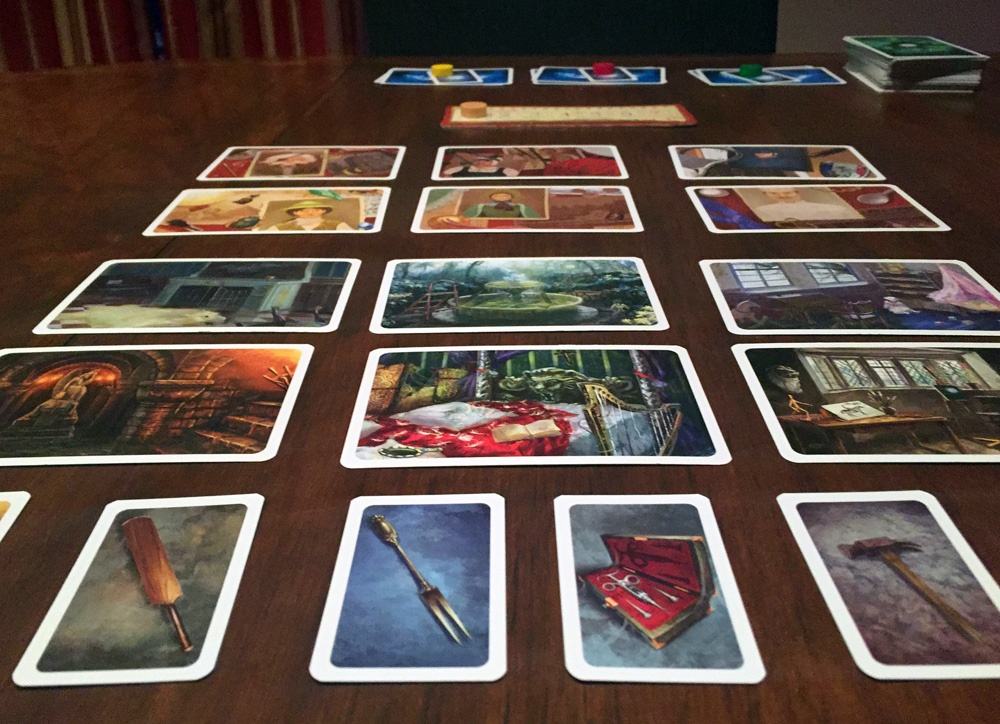
Game Experience:
I’ll come right out and say it; I think Mysterium is a fantastic game. The interaction, the deduction, the challenge, it all makes for a really rewarding experience.
Inevitably, there will be a lot of comparisons between Mysterium and Dixit. I think it’s because both use really abstract artwork as the central piece of their games. For me, while I do enjoy Dixit, I think Mysterium is a far superior game. One of the reasons is because Dixit is competitive while Mysterium is cooperative.
I’ve played a few games of Dixit with friends that play endlessly with their children. At this point, they’ve developed so many inside clues that we easily get steamrolled by them. It’s just the nature of the game when you play it that much, but not much fun for us on the outside. In Mysterium, everyone works together and cooperation is essential if you have any hope of winning.
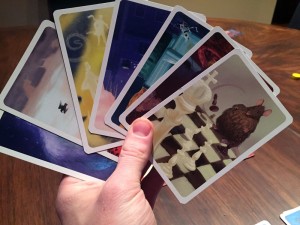
Even if you’ve played the game dozens of times, the only way a ghost can communicate with the players is through the cards. No talking, no pointing, not even a grunt. That removes the ability to use inside clues that might help give things away. Playing the ghost is actually really difficult and you truly don’t understand how hard it is until you sit in that chair.
I’ve played with first time players that call me crazy for some of my card selections I made as the ghost. But once they take their turn, it quickly dawns on them just how hard card selection is. Sometimes you have nothing that works, but you have to be careful because playing a bad card can easily steer a player in the wrong direction. So what you decide NOT to hand out can be just as important as what you DO.
But that’s also one of the charms of Mysterium that will give it a lot of replay value. The cards are so unique that I don’t ever see them being tied to just one card. The detail and creativity on them are pretty amazing.
Another area where Mysterium excels is through its player interaction. Players will endlessly be talking, discussing and working together to figure out which card is theirs. It’s rare for the ghost to have the perfect card for an investigator, so usually a lot of collaboration is required to solve this crime. It’s rare when we don’t put our heads together over every card handed out.
For me, some of the most fun comes from playing the ghost role. I like steering the ship and handing out cards. It can be frustrating though when you clearly don’t have any good cards to pass. Interesting enough, the ban on verbal clues stops you from even apologizing when you send a crappy card across the table. So the investigator doesn’t even know when you passed them junk. The verbal ban can also lead to a lot of head shaking by the ghost as you watch players take a card you passed them and go completely off the rails with it. Sometimes I just want to grab their face and yell “That’s not what I meant at all!”
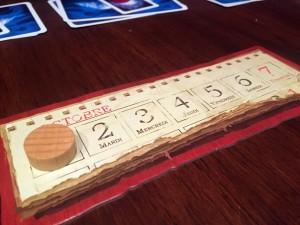
The one down side of playing the ghosts is the constant referencing of the player cards. Mysterium could have REALLY used some card trays. Having to constantly pick up and put down player cards to try and match them to your dream cards can be a chore. I’m planning on picking up some plastic card stands (or vulturing them from another game) to allow me to always have the cards facing me. I think this would cut done on the fiddlyness of the ghost role a lot and speed up choosing cards.
But that’s honestly the only bad thing I have to say about Mysterium. It scales fairly well, while 2 players isn’t the best way to play, it’s still good at that level. Where Mysterium really shines is when you get into the 4-5 player range. At this point, there are enough cards on the table to make for some hard decisions, but you also get a lot of minds working together. This makes for an extremely rewarding win if you can pull it off.
Final Thoughts:
Mysterium ended up being a surprise hit for me. I had not heard anything of it (I’ll be honest, I’m not up to date on Polish gaming) until I was able to try it at Gen Con 2014. After one play, I was hooked.
Mysterium is easy enough to play for it to be a good family game, but challenging enough that even seasoned gamers will enjoy it. The asymmetrical game play, combined with the unique artwork on the cards, ensure that Mysterium has a healthy amount of replay value.
I really didn’t have much in the way of complaints with Mysterium and it has already made its way to my gaming table quite often. If you are looking for a great cooperative game that’s both highly interactive and really challenging, try out Mysterium.
If you’d like to grab a copy for yourself, it’s currently only available in non-English languages. However, the game uses no text, so you can easily play with any version. You can pick up a copy of Mysterium now for about $36.
Final Score: 4.5 Stars – A fun and challenging cooperative game that constantly has me coming back for more. Get your copy today!
 Hits:
Hits:
• Great artwork
• Challenging game play
• Scales well
• Highly interactive
Misses:
• Needs a card holder for the ghost







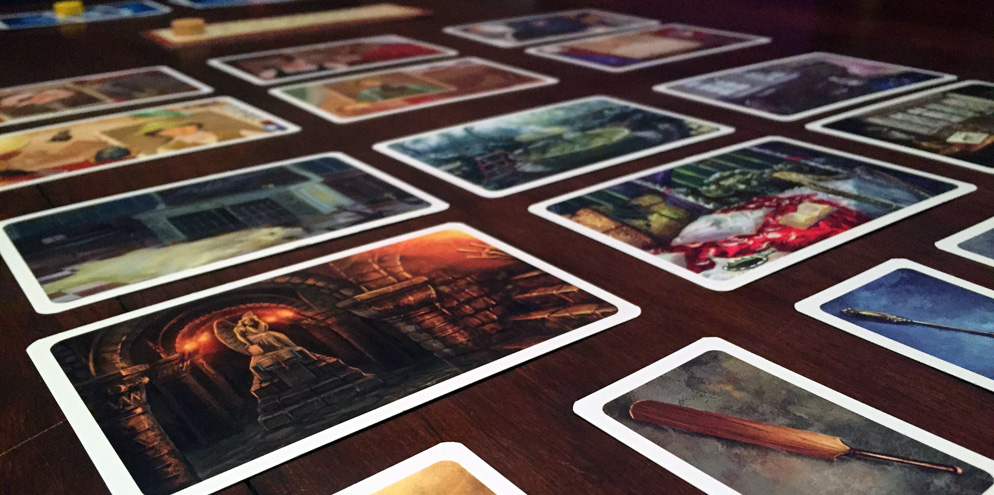















I’m astounded by all the positive reviews for this game online. Spent 2 fruitless hours trying to figure out the convoluted directions and keep track of the endless tiny cardboard pieces and weird cards before just giving up and throwing the whole mess back in the box, where it will doubtless remain. What a complete waste of $50.
Try and watch some videos on the game. Once you start playing it is really simple and a lot of fun!
$65 convoluted copy of clue. Sure to turn a night with friends or family into a dull and confusing pain in the butt. Horrible choice.
Thanks for the comments Johnny, and while you are certainly entitled to your opinion, I stand by my thoughts in the review. We had no issues learning to play and had a blast.
I agree that the instructions for this game border on mystifying and are poorly laid out. The fact that I need to find videos to figure out how to play is telling.
The game mechanic is way too simple to be entertaining. It plays a little bit like guess who with cards to communicate. You have to identify the correct card from the clue given by the ghost, you have 7 rounds to get 3 cards, that is it, . Little shocked at the number of positive reviews this game gets. I was hoping for a fun and rewarding experience but after playing 2 games with my friends I don’t think we will ever play it again. 2 out of 5. Nice artwork, one trick pony, little game play.